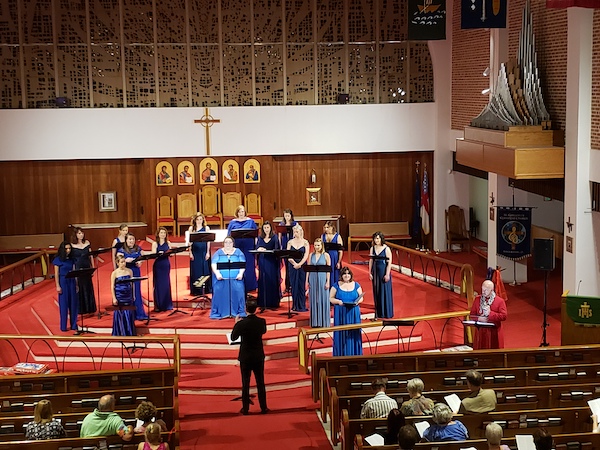Seraphic Fire conjures the otherworldly mystery of Hildegard in season opener

From a distance of nearly 900 years, the otherworldly music of the mystic nun Hildegard of Bingen soared Thursday evening through St. Gregory’s Episcopal Church in Boca Raton.
The Miami choir Seraphic Fire opened its 18th season this week with a series of performances of Hildegard’s Ordo Virtutum, a sort of opera or oratorio that tells of the struggles of an unnamed female soul torn between the virtues and the Devil.
Hildegard was a 12th century abbess, mystic and polymath, whose multiple interests and skills have made her a contemporary icon of feminists, herbal medicine practitioners and the New Age movement. And as Seraphic Fire’s artistic director Patrick Dupré Quigley observed in pre-concert remarks about this “exercise in musical archaeology,” she is the first composer whose name we actually know, all of her predecessors being anonymous.
Her Ordo Virtutum, or Order of the Virtues, tells of a Soul pulled in the direction of worldly concerns by the Devil and toward higher aspirations by the virtues. There are sung roles such as Mercy, Victory, Patience, Discretion, Charity. Humility and Fear of God. All roles were performed by women singers, except for the spoken role of the Devil.
Concert performances of religious works have long been common in the classical world. We’re accustomed to experiencing the church music of Bach, Handel, Mozart and many others as purely works of musical imagination that can be appreciated at the same level as a symphony or concerto.
More difficult is Hildegard’s almost wholly unharmonized music, with a melodic and dramatic vocabulary that will be foreign to most listeners, and where the religious text is as important as the music. To the credit of Quigley and the 16 women singers, they did nothing to dumb it down, jazz it up or otherwise try to mask the work’s remoteness in time and sensibility. There were simple costumes, with the Soul clad in a dark purple robe, the Virtues in blue and the Devil in (surprise) red.
There were a few brief symbolic bits of action, as the Devil was chained or the Virtues lifted their hands toward heaven. But this performance felt very much like something from a long past world.
Yet the humanity of the work came through despite the distance of centuries—in the words that expressed the striving of the soul, and her failures and successes as the Virtues tried to encourage and inspire her.
And it came through in the singing, in long flowing lines sung with an apparent freedom from the rigidity of a rhythmic grid and with a vocal bloom that seemed far from the dour formality with which many associate Medieval chant. Quigley, who worked with a Hildegard scholar at the Eastman School of Music in preparing these performances, seemed to respect the original while doing his best to recreate how it must have felt to performers and audiences at the time.
As usual, the intonation was close to perfect and the tones pure but without ever coming off as cold, pristine and mechanical. Drama and intensity came through, not in sudden increases in volume or harmonic richness, but as phrases took on a longer line, with the singers drawing out the emotion by performing them in a single breath.
The music also went high at crucial moments, soaring through the church as the music drew sudden attention to texts that would not have seemed so vital had the women’s voices not suddenly arched high in their delivery, such as “O most serene observer we have the confidence to come to the true fountain through you.”
Although recordings of Hildegard’s music are extremely popular, this work gained more than most music from being experienced in person. There wasn’t much to the staging, but the simple but effective layout enhanced the drama, as the Virtues each addressed the Soul, standing off to the right, with the Devil looking on next to her.
As the Soul, alto Luthien Brackett shaped each phrase with deep expression, without imposing a contemporary scale of emotion that would have stretched the music beyond its intentions. The feeling came though in rich, full tones and seamless melodic lines, as she sang of the burden of the physical body and the difficulty of fighting its demands. She went high effortlessly, as she praised the virtues as shining in the “highest sun.” And she brought stern defiance to her ultimate rejection of the Devil.
In the spoken role of the Devil, James K. Bass, with his close-cropped beard and deep voice, was subtle, convincing and intimidating.
Seraphic Fire performs Hildegard von Bingen’s Ordo Virtutum 7:30 p.m. Friday at St. Philip’s Episcopal Church in Coral Gables; 7:30 p.m. Saturday at All Saints Episcopal Church in Fort Lauderdale; and 4 p.m. Sunday at All Souls Episcopal Church in Miami Beach. seraphicfire.org
Posted in Uncategorized
Leave a Comment
Fri Nov 8, 2019
at 1:06 pm
No Comments